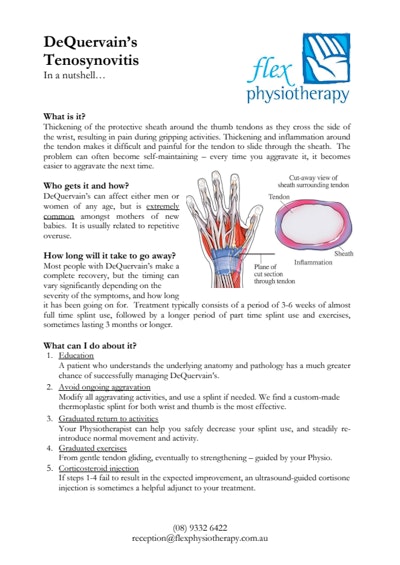DeQuervain's Tenosynovitis
What is it?
Thickening of the protective sheath around the thumb tendons as they cross the side of the wrist, resulting in pain during gripping activities. Thickening and inflammation around the tendon makes it difficult and painful for the tendon to slide through the sheath. The problem can often become self-maintaining – every time you aggravate it, it becomes easier to aggravate the next time.
Who gets it and how?
DeQuervain's can affect either men or women of any age, but is extremely common amongst mothers of new babies. It is usually related to repetitive overuse.
How long will it take to go away?
Most people with DeQuervain's make a complete recovery, but the timing can vary significantly depending on the severity of the symptoms, and how long it has been going on for. Treatment typically consists of a period of 3-6 weeks of almost full time splint use, followed by a longer period of part time splint use and exercises, sometimes lasting 3 months or longer.
What can I do about it?
- Education: A patient who understands the underlying anatomy and pathology has a much greater chance of successfully managing DeQuervain's.
- Avoid ongoing aggravation: Modify all aggravating activities, and use a splint if needed. We find a custom-made thermoplastic splint for both wrist and thumb is the most effective.
- Graduated return to activities: Your Physiotherapist can help you safely decrease your splint use, and steadily re- introduce normal movement and activity.
- Graduated exercises: From gentle tendon gliding, eventually to strengthening guided by your Physio.
- Corticosteroid injection: If steps 1-4 fail to result in the expected improvement, an ultrasound-guided cortisone injection is sometimes a helpful adjunct to your treatment.

